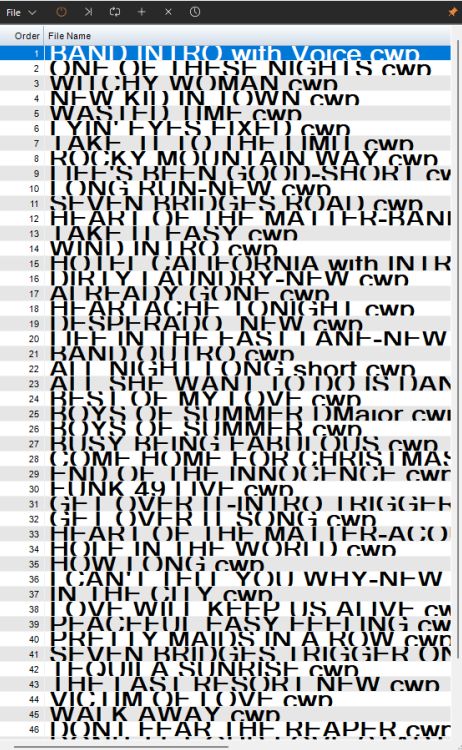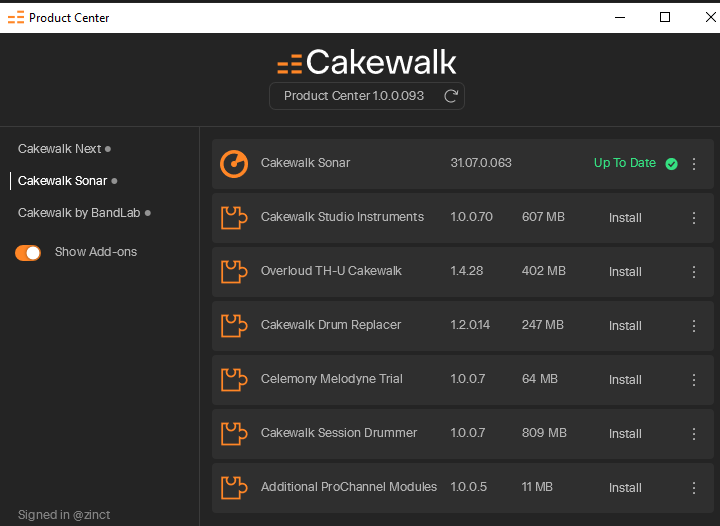-
Posts
2,078 -
Joined
-
Last visited
-
Days Won
51
Posts posted by Jonathan Sasor
-
-
1 hour ago, tdehan said:
Trying to add ProChannel preset to one of my projects in Sonar throws error and crashes Sonar. I've attached the .txt associated with the .dmp file which is to large to upload and which I have no idea how to read or rather should say don't know what I am looking for in it. it does not throw and error or crash when doing the same thing in Bandlab Cakewalk.
Can't Stop The Feeling-deleted-tracks6_LIVE_07122025_122631.txt
Use a file sharing service like google drive, Dropbox, or one drive to upload the dump file to, then post a link either here or via the form in "report a problem" in the help menu of the app.
-
1 hour ago, Leander said:
That's not showing the device you're actually using currently, its just a list. Go up to the devices tab of the Preferences and make sure the correct one is selected there.
-
4 hours ago, Steve Moddelmog said:
No luck here signing out and signing back in again. Even tried uninstalling (and doing a deep uninstall with Revo), but still no success.
We discovered an issue related to changes on the back end and have just pushed a new version of Product Center. If you launch it now, it should require you to update, and the new version should work. Thanks!
-
 3
3
-
-
20 minutes ago, ZincT said:
Thanks @Jonathan Sasor
After a bit of searching I found the Product Updates on the Quick Start Screen which only shows TH-U and Session Drummer 3, so I guess I have all of the ProChannel modules now (looks that way...see below).
I have TH-U anyway so I guess there's no need to download that but is Session Drummer 3 different to the one I already have installed from CbB/SPlat/X3?
Aside from a small installer difference, it's the same Session Drummer 3.
-
 1
1
-
-
-
14 minutes ago, deflint said:
No luck after signing out and signing back in to Product Center.
Everything is working fine but not knowing exactly what the additional ProChannel Modules are it's hard to verify any additional modules are installed.
Doesn't look like any more than the standard ProChannel modules I've always seen.
There's a known issue with Product Center not showing that the ProChannel additional modules are installed. Within Sonar itself, you'll notice that the entry for that disappears from the Updates tab of the Start Screen after it has been installed. That particular installer includes the PC2A Leveling Amplifier and ProChannel Concrete Limiter.
-
 1
1
-
-
21 hours ago, dtrebel said:
I'm disappointed too! New Cakewalk Sonar free-trial - great! load projects impressed! after update cannot even load a FX Vst from Cakewalk (LP Multiband) without crash/hang. I was ready to make the jump to the membership, (already a customer) but now I'll be very impaient, like the rest of the 100m members, waiting for a true fix and a solid version... UGH!
Which version of the LP Multiband is crashing for you? Can you provide a crash dump for the crash so we can investigate? Details on that here:
-
Its rendering the options, but just at a very low contrast in the Dark theme. This is already fixed internally, and we'll have another update soon.
-
 3
3
-
 1
1
-
-
5 hours ago, Js_MSN_SN said:
Hi there,
It happened again yesterday (2025/07/10), I had to do the lyrics editing in a separate Windows notepad, copied the text one phrase at a time to the Windows clipboard and then pasted it back to the Cakewalk Sonar lyrics window using the paste function of the lyrics window. It's a workaround that I think of (if I cannot use Cakewalk by Bandlab). But it's a trial and error experience that worked.
I'm certain that it has nothing to do with the monitor. I use
the one monitor builtin to the notebook computer.
Can you please provide more specifics as to how it isn't working and provide the details about how your display is configured? Your resolution and/or display scaling in Windows and/or monitor position can all potentially impact things.
-
-
-
22 minutes ago, Hotel California said:
Bearing in mind we don't officially support running in Parallels, this particular issue is already fixed and will be in the next update.
-
 1
1
-
-
1 hour ago, gmp said:
I can't install Sonar on a 2nd computer, because it won't let me change the HD from D:\Cakewalk Content to F:\Cakewalk Content. I tried both advanced and Basic install and tried it without installing Cakewalk Product Center and with installing it. The window is greyed out.
I need to install it on a 2nd computer for testing purposes, since I've found some bugs and have gotten no response from this thread
That's because you have an existing defined install path. You would need to do a clean install to remove the shared reg key to change the path
-
 1
1
-
-
18 hours ago, Anders Svensson said:
Hey!
I just noticed the solution has changed slightly. The setting has changed name to "Enable DPI Awareness (Requires Restart)".
It's still in Edit -> Preferences -> Customization -> Display.Cheers!
Bear in mind that will turn off the display scaling handling across the board for the entire app. For VST plugins, there's individual option in the settings cog per plugin, but that's not available for DirectX instruments.
-
 1
1
-
-
The one on the legacy site is the correct one, as linked in the post above.
-
 1
1
-
 2
2
-
-
4 hours ago, MisterGreen said:
What happened to the option to select the preview bus on the Browser's Media tab? It's no longer in the drop down.
In addition to the right-click method, it's also in the Project menu

-
 1
1
-
-
49 minutes ago, ZincT said:
I have installed Sonar (paid) but nothing else from the Cakewalk Product Centre.
As per the title, when I view my ProChannel Modules they appear in Sonar as follows:
I assume these are being picked up from my CbB (and SPlat, X3 etc) installation and they seem to work okay.
So, do I need to install the ones included with Sonar or will the existing ones work fine?
Also are there any new modules in the Sonar version and if I do install it to get these, will the other modules still work fine?Ditto Session Drummer and Studio Instruments.
The PC Module installer also includes Concrete Limiter, which it doesn't appear is in your list, so you may want that. Session Drummer and Studio Instruments are the same as with previous versions.
-
 1
1
-
-
Project5 predates a downloadable installer, therefore there are no legal ways to download it. You'd need to be running Windows XP or earlier for a supported platform as well.
-
If its installed and not showing in region fx, something with the scan may not have completed successfully.
-
14 hours ago, Gary Shore said:
Jonathan-
Much thx for taking the time to reply to my post above man;great to know you're part of the discussion over here and that we have BL staff people like yourself/MS McLeod/Noel etc providing the kind of factual info all of us still familiarizing ourselves w/everything involved in this migration > Sonar can rely on....
Planning on setting up a new thread along the lines of the current one focusing in on some specific aspects of the transition process I've been unable to find clear concise info about within the next few days.....however to continue going over the Drum Replacer situation in light of John V.'s posts above (which led to my starting to wonder about things again after "breathing a sigh of relief" immediately after going over your reply)>
Leaving aside the directly-related subject of DR itself being available for usage as part of the ARA options in the Sonar free tier momentarily ,my actual situation is a current project which uses DR and where some of the individual drum kit tracks have been bounced while others are still active DR tracks(i.e.liked the sample layering results I got for the tambourine so this has been bounced;still working on the sound design for kick/snare so these are DR tracks)...
Been focusing more on some other aspects of the track completion process w/a working drum track in place-so my concern is being able to continue working on things in Sonar w/"everything intact" (as so many of the thread postings I've been seeing over here/in the various Facebook Cakewalk groups suggest will be the case)vs.some kind of "worst case scenario" where the project opens in Sonar without DR and I have to figure out how to get things re-established before being able to continue....
As your time permits I'd really appreciate the opportunity to keep going over this stuff and get a full understanding of what's involved....and once again much thx for making yourself available over here...
There haven't been any changes to Drum Replacer recently, so if it's not in the Region FX menu, it sounds like there was an issue with it getting registered in the VST scan.
-
2 hours ago, John Vere said:
@Jonathan Sasor Drum replacer is not available in the free Sonar on the two computers that I in have installed it on.
My insert regional effects list only shows Vocal sync.
Not a problem as I rarely got it to work as expected. It’s got great potential when combined with stem separation to create a midi drum track using the original recording.
It's a separate install from the app itself, but it's available in either the updates tab of Sonar or CPC. I've used Drum Replacer on stuff on many occasions over the years, just have to dial it in.
-
35 minutes ago, gmp said:
I just installed Sonar Free and under preferences it doesn't have Themes. Years ago I spent a long time on my custom theme and wonder if there's a way I can use that. I never change themes, I just use the same one I created.
Themes from previous CbB/SONAR versions are not compatible with the latest Sonar which has a vector based UI instead of bitmaps.
-
2 hours ago, Gary Shore said:
Hey John!Glad to see you're still actively involved over here helping us all figure everything out....
Like everyone else who just found out what's going on re-Aug.1,been studying all the threads here to better understand things...
Since I have a couple of current projects using both Drum Replacer and SI Strings,would really appreciate some clarification re-above i.e.-
"No "= they won't be available in Sonar free tier
OR
"No "= that won't be the case and,just like people have been posting re-the TTS-1,as long as you already have these installed in CbBL,they'll "seamlessly migrate" along w/everything else...
Sonar's Free tier includes Drum Replacer and the Studio Instruments suite, which if you already have CbB will then already be available to Sonar. TTS-1 was removed from Sonar/CbB installers a while back at Roland's request due to their desire to drop support for it.
-
39 minutes ago, pedwal wally wally wha said:
4 - turn windows clock back 1 month? I don't believe this would work
It won't.











Sonar 2025.07 Feedback
in Cakewalk Sonar
Posted
Product Center is a small utility app, it would be unnecessary to install it to another drive. You really wouldn't benefit from doing that. Sonar allows you to pick the paths in the same way previous Cakewalk/SONAR versions have. If you have previous versions on the same system, it'll already pick up the existing shared install paths